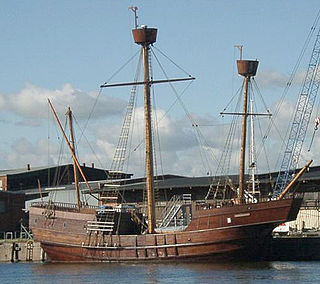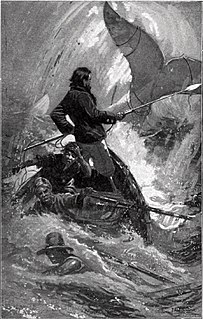
Maritime transport and hydraulic effluvial transport, or more generally waterborne transport, is the transport of people (passengers) or goods (cargo) via waterways. Freight transport by sea has been widely used throughout recorded history. The advent of aviation has diminished the importance of sea travel for passengers, though it is still popular for short trips and pleasure cruises. Transport by water is cheaper than transport by air, despite fluctuating exchange rates and a fee placed on top of freighting charges for carrier companies known as the currency adjustment factor. Maritime transport accounts for roughly 80% of international trade, according to UNCTAD in 2020.

A navigator is the person on board a ship or aircraft responsible for its navigation. The navigator's primary responsibility is to be aware of ship or aircraft position at all times. Responsibilities include planning the journey, advising the ship's captain or aircraft commander of estimated timing to destinations while en route, and ensuring hazards are avoided. The navigator is in charge of maintaining the aircraft or ship's nautical charts, nautical publications, and navigational equipment, and they generally have responsibility for meteorological equipment and communications. With the advent of satellite navigation, the effort required to accurately determine one's position has decreased by orders of magnitude, so the entire field has experienced a revolutionary transition since the 1990s with traditional navigation tasks, like performing celestial navigation, being used less frequently. Using multiple independent position fix methods without solely relying on subject to failure electronic systems helps the navigator detect errors and professional mariners are still proficient in traditional piloting and celestial navigation.

A ship replica is a reconstruction of a no longer existing ship. Replicas can range from authentically reconstructed, fully seaworthy ships, to ships of modern construction that give an impression of a historic vessel. Some replicas may not even be seaworthy, but built for other educational or entertainment purposes.

The Nautical Archaeology Society (NAS) is a charity registered in England and Wales and in Scotland and is a company limited by guarantee.
Roger Sarty is among Canada's leading historians, specializing in the history of Canada's Navy and coastal defence.
The North American Society for Oceanic History (NASOH) is the national organization in the United States of America for professional historians, underwater archeologists, archivists, librarians, museum specialists and others working in the broad field of maritime history. NASOH is an affiliated society of the American Historical Association.
Adriaan Hendrik Johan Prins, generally known as A. H. J. Prins was a Dutch Africanist and maritime anthropologist.
Nautical publications is a technical term used in maritime circles describing a set of publications, either published by national governments or by commercial and professional organisations, for use in safe navigation of ships, boats, and similar vessels. Other publications might cover topics such as seamanship and cargo operations. In the UK, the United Kingdom Hydrographic Office, the Witherby Publishing Group and the Nautical Institute provide numerous navigational publications, including charts, publications on how to navigate and passage planning publications. In the US, publications are issued by the US government and US Coast Guard.
The Society for Nautical Research is a British society that conducts research and sponsors projects related to maritime history worldwide.
The Canadian Nautical Research Society was originally established as the Canadian Society for the Promotion of Nautical Research, then incorporated 25 October 1984 under its current name and achieved the status of a registered charity shortly thereafter.

Niels Windekilde Jannasch was a German-Canadian mariner, marine historian and the founding director of the Maritime Museum of the Atlantic.
Daniel Gibson Harris (1915–2007) was an accountant, a British agent during World War II and a writer on Swedish naval history.
Mark C. Hunter is a Canadian naval historian and currently an employee of the Government of Newfoundland and Labrador.

Willem Fredrik Jacob Mörzer Bruyns,, is a Dutch historian of navigational science, specializing in the history of navigational instruments; he has also published on the history of the Dutch in the Arctic in the nineteenth century. He rose to be Senior Curator of Navigation at the Nederlands Scheepvaartmuseum before his retirement in 2005. Since 1972, Mörzer Bruyns published several books and a hundred-and-fifteen articles in scholarly journals, on the history of navigation and navigational instruments, and on the exploration of the Dutch in the Arctic, in the nineteenth century. He wrote seventy-five book reviews on these subjects in scholarly journals.
Pirate studies is an interdisciplinary field of academic study typically using historical and literary techniques to understand piracy and its cultural connotations.
David Moore is an American archaeologist and historian. He is best known for his work on the Blackbeard's Queen Anne's Revenge Shipwreck Project. The Queen Anne's Revenge was the flagship of the infamous pirate Blackbeard. He used her for less than a year, but she was an effective tool in his prize-taking.

Innes McCartney is a British nautical archaeologist and historian and a Research Fellow at Bournemouth University.

Nautical fiction, frequently also naval fiction, sea fiction, naval adventure fiction or maritime fiction, is a genre of literature with a setting on or near the sea, that focuses on the human relationship to the sea and sea voyages and highlights nautical culture in these environments. The settings of nautical fiction vary greatly, including merchant ships, liners, naval ships, fishing vessels, life boats, etc., along with sea ports and fishing villages. When describing nautical fiction, scholars most frequently refer to novels, novellas, and short stories, sometimes under the name of sea novels or sea stories. These works are sometimes adapted for the theatre, film and television.
Peter G Hore FRHistS naval officer, historian and obituarist, served a full career in the Royal Navy (1962-2000), spent ten years working in the cinema and television industry (2000-2009) and is a successful biographer and obituarist. One of his books, Habit of Victory, was the Daily Telegraph reader's choice and another book, Sydney, Cipher and Search was praised for its literary quality and depth of research and shortlisted for the Mountbatten Media Awards. His reasons for becoming an historian are published at British Naval History.
Roger Charles Anderson was an independently-wealthy English maritime historian, collector, and a leading figure in the early years of the Society for Nautical Research and of the Navy Records Society. Four times editor of the Mariner's Mirror, Anderson was also a founder trustee, and later chairman of the board of trustees, of the National Maritime Museum, Greenwich. He was a Fellow of the Royal Historical Society, a Fellow of the Society of Antiquaries of London, and held the higher Doctor of Letters degree. In 2005, the Swedish naval historian Jan Glete characterised Anderson as "one of the most important naval historians of the twentieth century. He mainly wrote about early modern warship technology and used his linguistic skills to write books and essays based on the literature from several countries."







